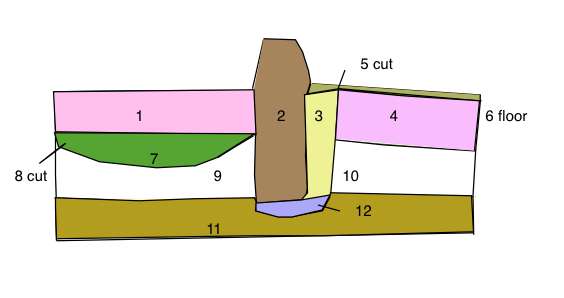Context (archaeology)
In archaeology context is used as a technical term referring to the remains of an individual stratigraphic event.[1] Contexts, therefore, are events in time which have been preserved in the archaeological record. The cutting of a pit or ditch in the past is a context, whilst the material filling it will be another. Multiple fills, seen as layers in archaeological section would mean multiple contexts. Structural features, natural deposits and inhumations are also contexts. By separating a site into these basic, discrete units, archaeologists are able to create a chronology for activity on a site and describe and interpret it. Artifacts in the main are not treated as contexts but belonging of them. Contexts can be referred to positive or negative depending on whether their formation added or removed material from the archaeological record. Negative contexts are cuts. It can not be stressed too strongly how fundamentally important the concept of context is in modern archaeological practice. Context is the prevalent term among English-speaking archaeologists but the term locus may also be used.[2][3]
Context types
Deposits and cuts are very commonly used context types. Beyond this there is little standardization.
- Deposit: Any soil deposit. These may have been caused naturally (e.g., a wash of colluvium) or by humans (e.g., structural or waste deposits)
- Cut: Any feature defined by action of removal of other contexts be it pit, ditch or truncation
- Masonry: Any masonry structure from steps to walls to stone-lined wells
Example of contexts

Take this hypothetical section as an example. Here there are twelve contexts, numbered thus:
- A horizontal layer
- Masonry wall remnant
- Backfill of the wall construction cut (sometimes called construction trench)
- A horizontal layer, probably the same as 1
- Construction cut for wall 2
- A clay floor abutting wall 2
- Fill of shallow cut 8
- Shallow pit cut
- A horizontal layer
- A horizontal layer, probably the same as 9
- Natural sterile ground formed before human occupation of the site
- Trample in the base of cut 5 formed by workmen's boots constructing the structure wall 2 and floor 6 is associated with.
The sequence of contexts on an archaeological site can be systematically described by a Harris matrix.
Suitability of single context recording
Single context recording is a system of recording and planning which treats each context on par in the process of excavation. The system of planning creates a superimposable stack of semi transparent plans that can be stacked in stratigraphic order to reconstruct the site as it was excavated. The use of context as discrete units does not necessitate single context recording but it does facilitate its use and popularity. Other methods of excavation such as removing spits of material make the recording of contexts more difficult.
See also
- Archaeological association
- Archaeological plan
- Archaeological section
- Cut (archaeology)
- Feature (archaeology)
- Fill (archaeology)
- Harris matrix
- Relationship (archaeology)
- Single context recording
- Stratigraphy
References
- ↑ Darvill, Timothy (2003). The concise Oxford dictionary of archaeology. Oxford [u.a.]: Oxford Univ. Press. p. 98. ISBN 0-19-280005-1.
- ↑ John Laughlin (4 January 2002). Archaeology and the Bible. Taylor & Francis. pp. 25–. ISBN 978-0-203-01521-6. Retrieved 22 April 2013.
- ↑ Hubert Schmidt (31 March 2003). A Central Asian Village at the Dawn of Civilization: Excavations at Anau, Turkmenistan. University of Pennsylvania Press. pp. 32–. ISBN 978-1-934536-23-0. Retrieved 22 April 2013.
- The MoLAS archaeological site manual MoLAS, London 1994. ISBN 0-904818-40-3. Rb 128pp. bl/wh